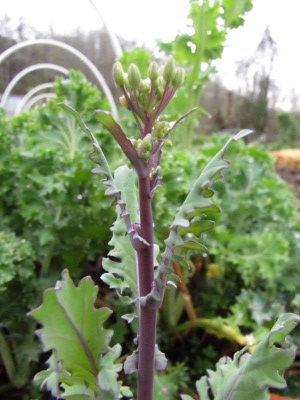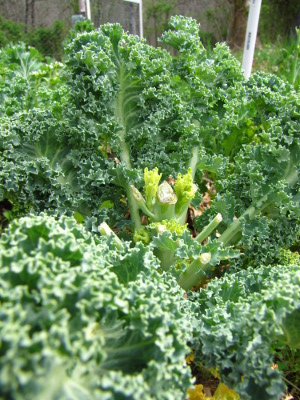
Saving kale seeds
 Saving
seed from kale is a lot more complex than I expected. We grew three
varieties this year,
of which Winterbor was my least favorite (not as productive and faster
to bolt in the spring without producing many leaves first). But
both Improved Dwarf Siberian and Red Russian are keepers, the first for
its cold hardiness and high productivity and the second for its color
and taste. What would I have to do to save seeds from both the
Siberian and the Russian?
Saving
seed from kale is a lot more complex than I expected. We grew three
varieties this year,
of which Winterbor was my least favorite (not as productive and faster
to bolt in the spring without producing many leaves first). But
both Improved Dwarf Siberian and Red Russian are keepers, the first for
its cold hardiness and high productivity and the second for its color
and taste. What would I have to do to save seeds from both the
Siberian and the Russian?
Seed
to Seed clued me in
to the fact that what we call kale can actually be in two different
species. The most common types of kale (including Winterbor) are
in Brassica
oleracea along with collards, broccoli, cauliflower, and
cabbage. On the other hand, some kales commonly called Siberian
or Russian are in Brassica napus along with rutabagas and
rape. (That said, some "Siberian" kales might be in B.
oleraceae, and
the source of my Improved Dwarf Siberian Kale lists it thus on their
website.)
To confuse matters even
more, Brassica
napus might not
really be its own species. Rutabagas appeared seemingly out of
nowhere in Europe during the Middle Ages, and some sources suggest that
varieties in this "species" arose from different hybridizations beween B.
oleracea and B. rapa (the latter of which contains
Chinese cabbage, Asian greens, turnips, and broccoli raab). For
example, Siberian kale might have sprung up when a B.
oleracea kale
crossed with a B. napa Asian mustard, while the
rutabaga might be a hybrid between kale or collards and a turnip.
This
website provides
evidence that Red Russian kales might be the result of a three way
hybridization when the already hybrid Siberian kale was crossed with
black mustard (B. nigra).
After doing all that
reading, my head was spinning and I still didn't know which kales cross
with each other. I digested for a while (and read some more) and
came up with these rules of thumb:
 You can hand-pollinate and
sometimes get crosses between species, but
you probably don't need to worry about unintentional cross-pollination
between plants in different species.
You can hand-pollinate and
sometimes get crosses between species, but
you probably don't need to worry about unintentional cross-pollination
between plants in different species.- Most kales (B. oleracea) are outbreeding plants that will hybridize with other kales in the same species and with cabbage, broccoli, Brussels sprouts, cauliflower, collards, and kohlrabi.
- Siberian kale might be in B. oleraceae, in which case see above. If not, see below.
- Russian kale, Hanover Salad, and Winter Rape kale (B. napus) are inbreeding plants, but will cross with other kales of the same type, and with rutabagas, some turnips, and winter rape.
(See
this post to understand what I mean when I talk about outbreeding and
inbreeding plants.)
As long as I rip out my
turnips (which I wasn't going to save the seeds of anyway), it sounds
like I can probably save Red Russian kale seeds with no extra
effort. (That's assuming that the seed company is right and
Improved Dwarf Siberian is in a different species --- I've emailed them
to confirm.) To save seeds from my Improved Siberian kale, I'll
just need to make sure that the few broccoli plants that survived the
winter don't go to seed and to eat up the last of our Winterbor kale so
it doesn't bloom. Maybe keeping two varieties of kale in my
garden is easy after all.
Want more in-depth information? Browse through our books.
Or explore more posts by date or by subject.
About us: Anna Hess and Mark Hamilton spent over a decade living self-sufficiently in the mountains of Virginia before moving north to start over from scratch in the foothills of Ohio. They've experimented with permaculture, no-till gardening, trailersteading, home-based microbusinesses and much more, writing about their adventures in both blogs and books.
Want to be notified when new comments are posted on this page? Click on the RSS button after you add a comment to subscribe to the comment feed, or simply check the box beside "email replies to me" while writing your comment.

hi, I'm growing Tuscan Kale, sometimes called dinosaur kale and since it's the only kale I'll be growing, as long as I've not got flowering broccoli or things like that nearby, it should be ok, right? I read about Seed Saver's Exchange some years back, and how they isolated different strains, by building screen boxes and putting them over the plants and releasing like flies or things in there to pollinate them. I'm going by memory so I could be wrong about that last part, but I think that's what they did. anyway, great blog guys, i link to it frequently and I think my readers are getting a lot of good info here. Keep up the good work and hope you have a great garden this season.
Pamela --- Yup, with one variety of kale, as long as you don't have other plants in the same species, you should have no problem saving seeds. Just be sure to leave a lot of plants (80 to 100 is recommended, although probably not feasible in the backyard) to bloom so that you won't see inbreeding depression.
If you have two varieties in separate beds, you can build mesh boxes (or just carefully cover them with row cover fabric) and uncover varieties on alternate days. (Seed to Seed gives a lot more information on this.) Carrots are a bit odd in that they require flies to pollinate them, which is probably what you're remembering ---- most of our garden vegetables are pollinated well by bees.
Personally, I'm still in the low-hanging fruit era of seed-saving. So I try to only save seeds of one variety per species, which makes my life very easy....
Ok, so biennials in general have me in tears for seed saving. Not enough garden for rotation is the starting problem. The two year cycle is hard enough and now you throw this klinker in the ring? baah, humbug. I might just buy these seeds over the long run.
However, once again, thank your for your enlightening research! I'm also about at the point of writing country music songs, a tear in my beer, level of singing about worrying about frosts on the way here in MN when I have budding fruit trees. You have an old set of charts on frosts and loss at different levels of budding, utterly awesome and thank you. It pushed me to write wunderground.com who will be offering a "local climate" function at the end of april for historical frost records and longer-term garden prediction help. Just an fyi as I'm excited.
mudgirl --- I know what you mean about biennials. I'm not going out of my way to save any, but the kale overwintered great, so I figured the opportunity was too good to pass up. I had such good luck saving tokyo bekana seeds last year (although they bolted, so no need to wait the extra year.) Things like broccoli and carrots, though, I don't plan to save them anytime soon, partly because the varieties we like are hybrids.
Funny you should have talked wunderground into adding garden-specific weather info. I was just telling Mark that I thought they should add a feature where you can tell them your actual low and high, and after a year or whatever, they could start giving you better estimates for your location. In the spring, our lows are often up to 5 degrees below their expected lows because we're on the north side of a hill down in a valley. I just do the math in my head, but it'd be nice if they could localize my prediction.